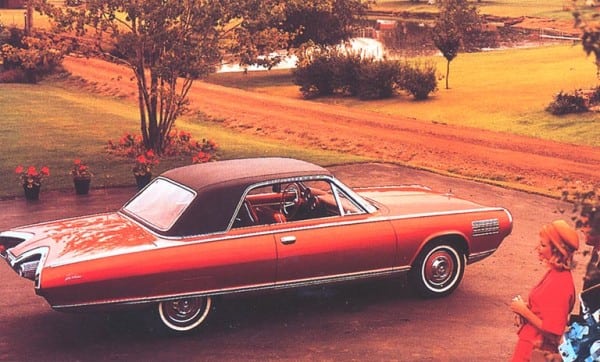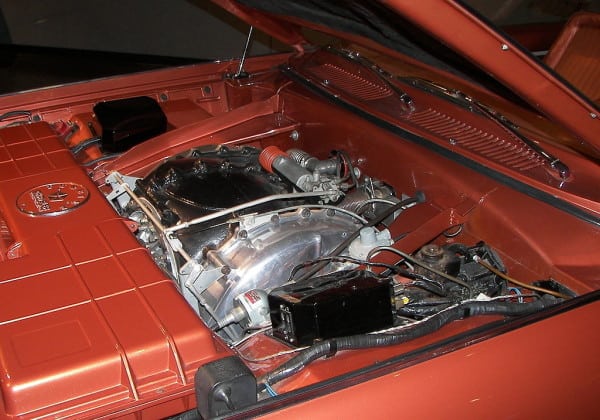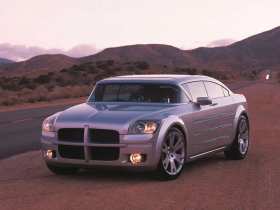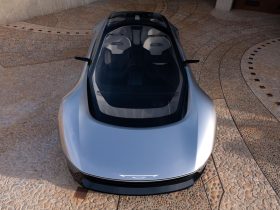The Chrysler Turbine Car was first shown in 1962 and then went into production in 1963, but only 55 total vehicles were actually made and of those, only 9 are still in existence. With a unique and beautiful design made by Ghia in Italy and a highly innovative engine that is still a subject of forward-thinking research today, the Chrysler Turbine was a grand experiment in all angles of design. So much so that a new tribute concept was showcased in Detroit based on the current-model Chrysler 300. Jay Leno has described the Chrysler Turbine as “the most collectible American car.”
The Design
Credit for the Turbine Concept’s design goes to Charles Mashigan and Elwood Engel, though actual background on the design concept is a little sketchy. Many attribute the look to the Typhoon concept showcased at the 1964 World’s Fair in New York City (where the Turbine also made an appearance), but Elwood almost certainly used his past at Ford and the nearly-identical rear end of the 1958 Ford la Galaxie design study. The overall look of the car is also very similar to the Ford Thunderbird of the time, especially in interior configuration and the look of the hardtop and greenhouse configuration.
The overall look of the Chrysler Turbine was contemporary to the time, though, with shape and contour not much different from most production vehicles in the coupe segment, befitting the Turbine’s production ambitions. The large, round headlights, thin, undercut grille, bumperless ends (the bumpers were actually integrated to the body), and chrome edging was definitely eye-catching, though, and the rear end was all jet engine exhaust in appearance, with its cone-style chromed reverse lamps and heavy chrome bezels.
Overall design for the Turbine was to evoke a jet turbine scheme, fitting its name, which is why the front is so simplistic compared to the rear – the spot where all the action is on a turbine engine.
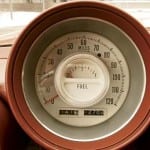 By far the most striking feature of the Turbine, of course, was the bright copper paint scheme that covered the body and hubcaps. This, accented by the chrome edgings, is what still marks the Turbine Concept today as its most recognizable feature. The actual color is called “Turbine Bronze” and was offered on limited editions of some Chrysler production vehicles after the Turbine’s run was through.
By far the most striking feature of the Turbine, of course, was the bright copper paint scheme that covered the body and hubcaps. This, accented by the chrome edgings, is what still marks the Turbine Concept today as its most recognizable feature. The actual color is called “Turbine Bronze” and was offered on limited editions of some Chrysler production vehicles after the Turbine’s run was through.
The interior of the car continued this bronze color scheme, with English calfskin dyed in the color and bronze-colored pile carpeting. The center console held with the jet turbine theme and chrome-on-bronze look. It featured electroluminescent panels and gauge pods that were innovative in and of themselves. Rather than use lamps to illuminate, these panels were layered plastic into which high-voltage power (100V AC, converted through a transformer from the car’s battery) was sent. This layering and voltage created a blue-green futuristic “jet plane” glow and fitting the innovative engine the vehicle used, details such as teh engine temperature gauge were set in number schemes by order of 500 (500, 1000, 1500, 2000 deg. F) to denote the Inlet Temperature for the turbine engine.
The Turbine Engine
The real innovation in the Chrysler Turbine Concept was the engine. It featured the fourth-generation of the company’s research into liquid-fueled turbine engines and could run at up to 44,500 revolutions per minute. It was capable of burning diesel fuel, unleaded gasoline, kerosene, vegetable oil, or even JP-4 jet fuel. Or any mix thereof, in fact, plus just about any other combustible liquid – even tequila as the then-President of Mexico attested. The only exception was leaded gasoline, which left debilitating deposits on the turbine engine that could throw it off-balance. Had the Turbine not been so far ahead of engineering capabilities for automotive at the time, we would all likely be driving turbines today. As it was, the engine alone had a cost of an estimated $30,000 or more per vehicle, giving the car a price tag today of around $300,000. And you thought a Tesla electric was expensive..
The engine required little maintenance and no adjustments to go from one fuel to the next, though mileage varied by fuel type and exhaust smells changed according to what was burnt. With only about 1/5 the moving parts of a standard piston-based internal combustion engine (ICE), the engine was extremely smooth and well-balanced. It didn’t even require oil changes, in fact, because the oil was used only to lubricate the spinning turbine and never got over-heated nor did it contact the combustion fuels. No liquid cooling was included either, with the engine being air-cooled and temperature-controlled through heat-sensing operation.
The turbine engine used in the 1963 “production” model of the Turbine was a 97 kW (130 bhp, 132 PS) that produced an immediate 425 lb-ft of torque from stall (0.1 rpm) and the 0-60 for the car, while only 12 seconds (at ambient temp of 85-degrees), was brisque for the time and held back mainly because of the engine’s temperature concerns. The cooler it was outside, the faster the Turbine could safely accelerate with some in colder climates clocking nearly twice that 0-60 time in anecdotal accounts. Further, with more than 1.1 million test miles conducted by the public in the Turbine, downtime was only 4% – less than a 1/3 of the average for vehicles of the time period and still far better than most today.
The Chrysler Turbine also featured what we would now consider a very “green” exhaust. It had no carbon monoxide, unburned carbon, or raw hydrocarbons. It did produce NOx gases, which Chrysler engineers worked hard to limit throughout the testing process.
Another innovation was in the way the TorqueFlite automatic transmission worked. Rather than the conventional torque converter and its requisite lubrication and complexity, engineers seized on another property of the turbine engine: combustion gas control of gear shifting. This interesting innovation replaced the torque converter with a simple gear reduction unit and a gas generator. Combustion gases flowed between the gas generator and the free power turbine/reducer and provided the same function as a torque converter would, creating gear shifting without the complex parts. Twin rotating recuperators transferred exhaust heat to the inlet air, which also improved fuel economy – something that wouldn’t be seen on modern engines until only recently on diesels.
Drawbacks That Kept It Off the Market
With all of this innovation, the Chrysler Turbine had some real drawbacks that would keep the company from seriously pursuing the vehicle as a production model. Throttle lag, engine sound, exhaust temperatures, and fuel consumption were primary in these concerns.
The car’s slow (though relatively contemporary non-sport) 0-60 time was largely due to the lag between throttle press and actual acceleration. The turbine engine requires time (compared to most ICE options) to ramp up. This creates a short lag that required a lot of adjustment for the driver. Our habits, thanks to gasoline ICE, are rooted in pressing the “gas” and going immediately. With the turbine, the slower it’s spinning, the less you’ll get in power and the engine requires several milliseconds to react to fuel being added (accelerator press). To the driver, this creates a noticeable pause before acceleration. Starting from zero, this can be made up for by ramping the accelerator before letting off the brake (in drag racing style), which requires some practice.
Further, the engine sound is akin to a scaled-down jet engine rather than a big, throaty V8. At the time, this was a huge drawback as people expected to hear powerful-sounding grumbles from their vehicle, not whining vacuum-like noises. Engine starting, warming, and high-altitude operation also lowered the car’s potential consumer appeal. Opposite a standard piston engine, the turbine was a large learning curve as most of the conventional wisdom for automotive engines of the time did not apply – starting required the turbine to heat up to operating temperature, which meant “warming” it through idling – adding fuel (the usual “warm the engine faster by pressing the accelerator” idea of the time) only slowed this process and could cause engine stall. While the turbine does heat up quickly, it was not instant start-and-go like most ICEs.
Exhaust temperatures were another major concern. At the time, research into controls was relatively primitive, and the Chrysler Turbine engineers opted to use long, fully-stainless steel exhaust with a flat cross-section. This was meant to spread the exhaust for cooling before it exited. Rumors were that the exhaust was so hot that it could actually damage vehicles around the Turbine were it not cooled beforehand (Jay Leno busted this myth in Popular Mechanics). Modern turbines use annular combustion chambers and better power turbines to improve both fuel economy and exhaust temperatures.
Fuel economy for the Chrysler Turbine was horrible, even by the day’s standards of 8-10 mpg vehicles. Chrysler never produced numbers (it was not common at the time), but anecdotal accounts give the Turbine an MPG rating of about 6 mpg on average.
Where Is It Now?
The Chrysler Turbine was first shown in 1962 with five prototypes being built in various color configurations. It went to limited test production in 1963 as the 1963 Chrysler Turbine and fifty vehicles were made through 1964 when production ceased. The bodies were made almost entirely in Italy, shipped to Detroit and put on the chassis with the engine and transmission then added.
The fifty test production vehicles were given to various members of the public for real-world testing. At the time, this was an unusual idea, but with the highly innovative and very different powertrain and operation, it was seen as a requirement for both understanding the potential market and testing the vehicles in actual everyday use. This deployment was similar to what would be used for future test powertrains, including the GM EV1 and today’s hydrogen fuel cell vehicles from Toyota, Honda, and others.
After the test period ended, Chrysler decided not to pursue the vehicle as a full production car and scrapped (destroyed) 41 of the cars produced for tax and liability reasons. Of the other nine, six had their engines deactivated and were given to museums around the country. Chrysler kept the other three for historical and possible future research. One of those is still owned by the Chrysler Heritage WPC Museum and another is owned by the Museum of Transportation in St. Louis. That latter one is the one most often seen at car shows and displays. The rest of the de-activated models, other than the one noted below, are in museums, including one in the Smithsonian.
Two deactivated cars are in private hands, including one in Indiana which its owner, Frank Kleptz has re-activated and made operational. Another Turbine is owned by Jay Leno and was purchased from the WPC Museum as an operational vehicle.
The Turbine Project continued, however, with Chrysler producing more concepts using the technology, including the 1966 Dodge Coronet with a sixth-generation turbine. A seventh-generation turbine, which was smaller, lighter, and met NOx emissions requirements, was produced in 1977 as a Chrysler LeBaron concept. It was never produced because of U.S. loan guarantee requirements the company accepted in order to avoid bankruptcy.
The turbine engine continues production, but not in traditional automotive. It is the Honeywell AGT1500 being used in the M1 Abrans Main Battle Tank.
This year, Chrysler showcased a tribute vehicle, a specially-painted Turbine Bronze 2013 Chrysler 300 which appeared at the North American International Auto Show in Detroit this year. Video of the original Chrysler Turbine and the making of the tribute car is on our YouTube channel.
Many thanks to Dickey in the Garage Journal forum for the clarification on exhaust temps.




